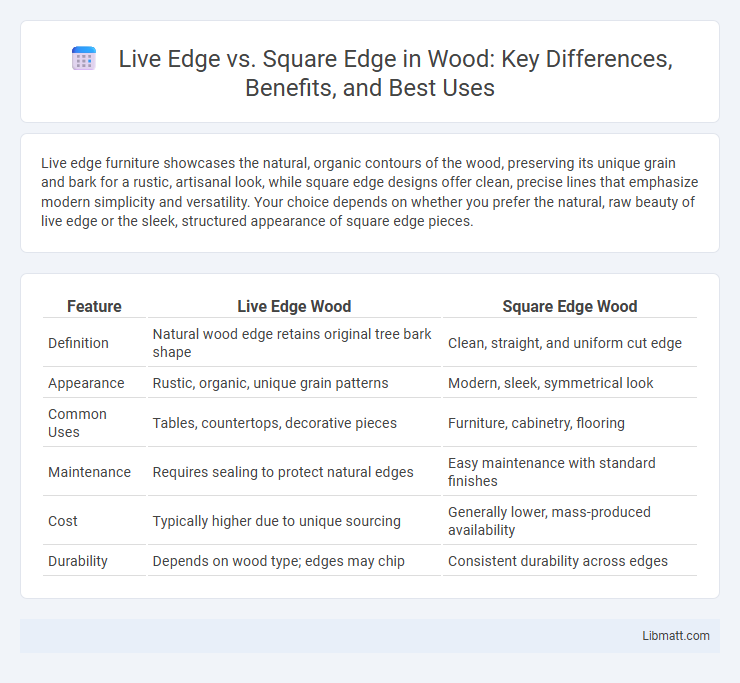Live edge furniture showcases the natural, organic contours of the wood, preserving its unique grain and bark for a rustic, artisanal look, while square edge designs offer clean, precise lines that emphasize modern simplicity and versatility. Your choice depends on whether you prefer the natural, raw beauty of live edge or the sleek, structured appearance of square edge pieces.
Table of Comparison
| Feature | Live Edge Wood | Square Edge Wood |
|---|---|---|
| Definition | Natural wood edge retains original tree bark shape | Clean, straight, and uniform cut edge |
| Appearance | Rustic, organic, unique grain patterns | Modern, sleek, symmetrical look |
| Common Uses | Tables, countertops, decorative pieces | Furniture, cabinetry, flooring |
| Maintenance | Requires sealing to protect natural edges | Easy maintenance with standard finishes |
| Cost | Typically higher due to unique sourcing | Generally lower, mass-produced availability |
| Durability | Depends on wood type; edges may chip | Consistent durability across edges |
Introduction to Live Edge and Square Edge
Live edge slabs feature natural, organic edges that preserve the original shape and bark of the wood, creating a unique and rustic aesthetic. Square edge slabs are precisely milled with straight, clean edges, offering a modern and uniform appearance that suits contemporary designs. Both options cater to different interior styles, balancing natural beauty with functional precision.
Key Differences Between Live Edge and Square Edge
Live edge wood features natural, irregular edges that preserve the tree's original shape, enhancing organic aesthetics and unique character for furniture and countertops. Square edge wood offers clean, straight lines and precise angles, providing a sleek, modern look ideal for contemporary design schemes. The choice impacts both style and functionality, with live edge emphasizing rustic uniqueness and square edge prioritizing uniformity and ease of installation.
Aesthetic Appeal of Live Edge vs Square Edge
Live edge wood showcases the natural contours and organic textures of the tree, creating a visually striking and unique aesthetic that emphasizes rustic charm and natural beauty. In contrast, square edge wood offers clean, sharp lines and a uniform, modern look, ideal for minimalist or contemporary interiors. The choice between live edge and square edge significantly impacts the overall ambiance, with live edge adding warmth and character, while square edge promotes sleekness and precision.
Durability and Maintenance Considerations
Live edge wood retains the natural contours and bark, making it more susceptible to damage and requiring regular sealing to prevent moisture infiltration and warping. Square edge wood features straight, uniform edges that allow for easier installation and cleaning, resulting in lower maintenance demands and improved durability under heavy use. Choosing between live edge and square edge should account for exposure to humidity and wear, as square edge surfaces generally offer greater resistance to everyday wear and tear.
Cost Comparison: Live Edge vs Square Edge
Live edge countertops typically cost more than square edge options due to the unique natural contours and extra labor required to preserve the wood's organic shape. Square edge designs are more cost-effective, benefiting from standardized cuts and easier installation processes that reduce overall expenses. Your choice will impact budget considerations, with live edge surfaces offering a bespoke aesthetic at a premium price point compared to the more affordable, clean lines of square edging.
Common Uses and Applications
Live edge wood is commonly used in creating unique, natural-looking furniture such as dining tables, coffee tables, and benches, where the organic shape highlights the wood's natural beauty and grain. Square edge wood is preferred for cabinetry, shelving, and flooring due to its clean, uniform lines that fit seamlessly with modern and minimalist designs. Your choice depends on whether you want a rustic, artistic appeal or a sleek, contemporary look for your project.
Design Versatility and Customization Options
Live edge wood offers unparalleled design versatility by preserving the natural contours and unique grain patterns of the tree, making each piece one-of-a-kind and ideal for rustic, organic aesthetics. Square edge wood provides clean, straight lines that suit modern and minimalist designs, allowing for precise customization in shapes and sizes to fit your specific space and style preferences. Your choice between live edge and square edge ultimately depends on whether you prioritize natural uniqueness or sleek geometric forms in your interior design.
Environmental Impact and Sustainability
Live edge wood retains the natural form of the tree, minimizing waste and preserving more of the original material, which reduces its environmental footprint. Square edge wood typically requires more processing and cutting, generating more wood waste and increasing energy consumption during manufacturing. Choosing live edge furniture supports sustainable forestry practices by utilizing more of the tree and promoting eco-friendly craftsmanship that benefits your environmental impact.
Choosing the Right Edge Style for Your Space
Live edge offers a natural, organic look by preserving the wood's original contours, adding warmth and character to your space. Square edge provides a clean, modern aesthetic with sharp lines, making it ideal for contemporary interiors. Your choice depends on whether you want a rustic, unique feel or a sleek, minimalist design to complement your decor.
Conclusion: Which Edge Style is Best for You?
Live edge offers a natural, rustic aesthetic that highlights the wood's unique grain and shape, making it ideal for those seeking an organic, artistic look. Square edge provides a clean, modern appearance with sharp lines that suit minimalist or contemporary interiors. Your choice depends on whether you prefer the raw character of live edge or the sleek precision of square edge for your space.
Live edge vs square edge Infographic

 libmatt.com
libmatt.com